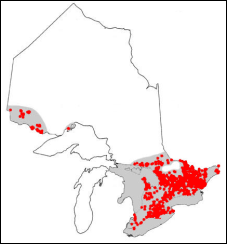Largemouth Bass
Information about the Largemouth Bass (Micropterus salmoides), a warm-water fish native to Ontario.

Species image (Illustration Credit: U.S. Fish and Wildlife Service)
What it looks like
- medium-sized, deep-bodied fish
- back and sides are green to olive
- belly is yellow to white
- broken horizontal stripe along body
- 9 to 11 dorsal fin spines
- deep notch between dorsal fins
- upper jaw extends beyond eye
Size
- length: 25-55 centimetres (10-22 inches)
- weight: 0.7-1.8 kilograms (1.5-4 pounds)
- Ontario record: 4.7 kilograms (10.4 pounds)
Similar fish
Where it is found

Species distribution map (modified from Mandrak and Crossman, 1992)
Range
- southern Ontario through the lower Great Lakes
- some populations in Northwestern Ontario
- use Fish ON-Line, an interactive mapping tool, to find specific lakes and rivers
Habitat
- warm, weedy water
- clear, rocky lakes
- shallow muddy ponds
- slow-moving rivers
Find a fishing spot with Fish ON-Line
Angling tips
- often found in thick weeds and near sunken wood
- overhanging trees and docks are good largemouth hideouts
- best times to fish are early morning and late evening – they tend to take shelter during the day
- when fish aren’t biting, change your lure and your tactic
- strong-fighting fish, eager to strike most artificial lures
- keen sense of smell – can be fooled by adding scent to artificial bait
- bass season opens the 4th Saturday in June in most of Ontario
Common baits
- spinnerbaits, buzzbaits, crankbaits
- topwater plugs
- jigs
- a variety of soft plastic baits
- minnows and crayfish
Updated: December 15, 2025
Published: July 18, 2014